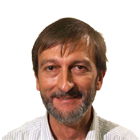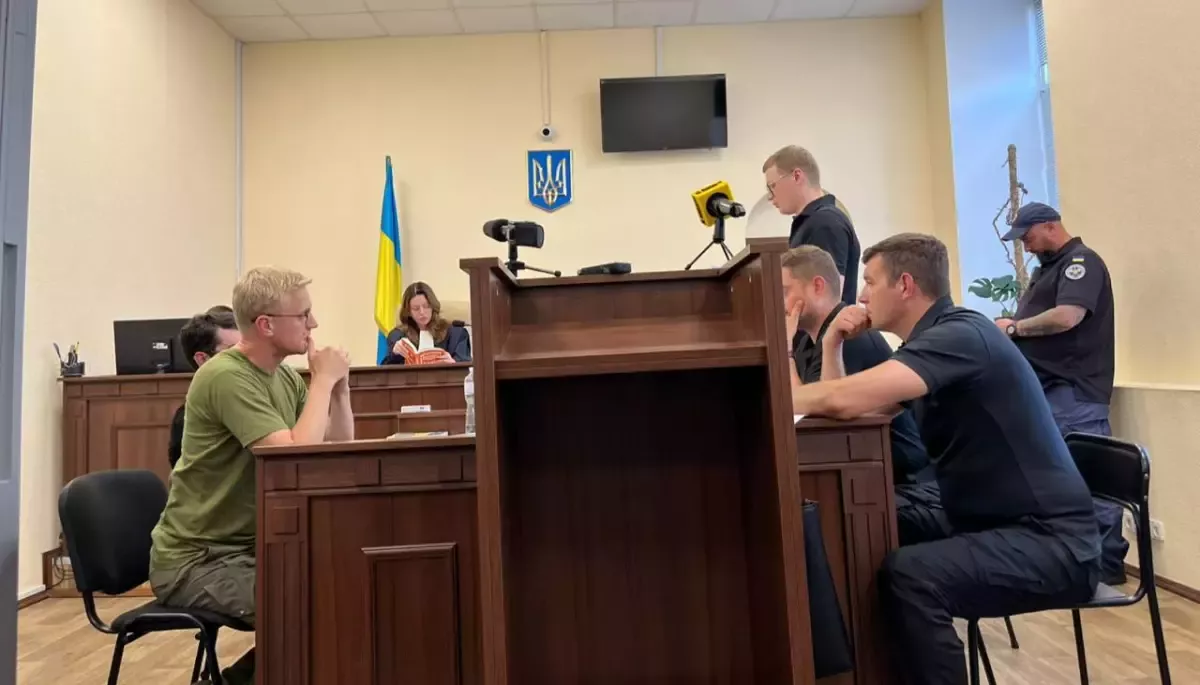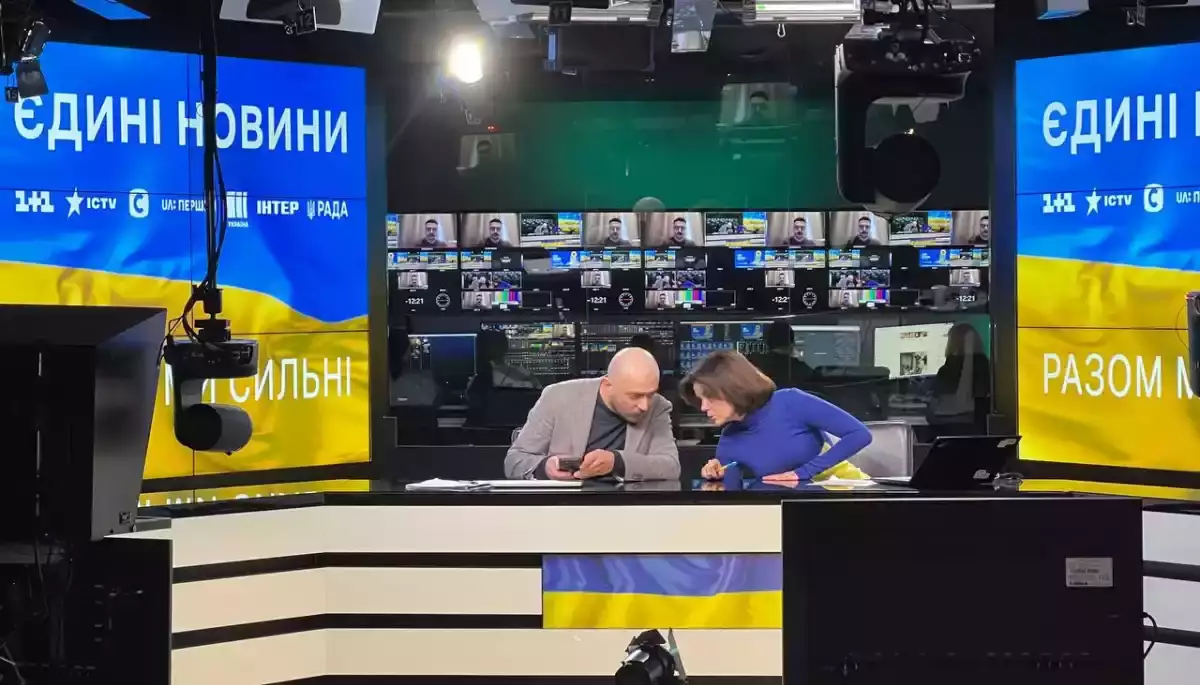
The results of the United News telethon monitoring for half a year (March — September 2022) Part One
The results of the United News telethon monitoring for half a year (March — September 2022) Part One


Українською текст читайте тут.
Our United News telethon monitoring has celebrated half a year anniversary. So, “Detector Media” is summing the intermediate results up and trying to determine general trends in the telethon. Obviously, the telethon has undergone changes according to different parameters over six months. The biggest “tectonic” shift was, of course, the withdrawal of the participating Rinat Akhmetov’s channels, following his closing of Media Group Ukraine. There were also changes in content, both general and at some channels.
For the monitoring I have estimated just one day of telethon broadcast per week, so the monitoring shows a discrete, interrupted picture. But, at a greater distance of six month, even this picture is illustrative and provides solid grounds to define some tendencies. For the statistic comparison of the different channels / media groups performance we had to take into account the fact that different amount of the different channels’ airing time was constantly caught in the monitoring, as the operating schedules for the channels in telethon were and still are “crawling”. So, it would not have been logical to use daily parameters for comparison, the average indicators per one broadcast hour could be mathematically comparable. Thus, do not be puzzled by the appearance of such notions as “1.5 guest in the studio per hour”. It is nothing more than pure mathematics :)
In part one of these half-a-year observations results I am going to analyse the telethon broadcast schedule and the way the TV channels dealt with guests. Other items will be included in part two.
Telethon Broadcast Schedule
Since the very beginning, the telethon broadcast was divided into 5-hour slots among TV channels / media groups. So, the broadcast “line-up” for different telethon participants was “crawling”. At the beginning of May, this division was changed to 6-hour slots, moreover, one of them covered two days (it began at 9 pm and lasted till 3 am of the following day). Media Group Ukraine was aired in the telethon for the last time on July, 22nd. Since that time, the daily broadcast has been split into four 6-hour slots. A channel / group, having the last quarter of the day, was responsible for the news summary at 8 pm. But somehow the telethon organizers have decided that a channel / group on the air during 6:00 pm - 00:00 slot continues to broadcast in 00:00-6:00 am slot of the following day. This hard-to-comprehend decision resulted in the night airs quality reduction because, as the monitoring shows, even the channels with the largest resource (for instance, “1+1” or “Inter”) were unable to maintain high quality during 12 working hours and had to “fill” the night air with repeats. Accordingly, the fixed broadcast schedule of each channel / group is also disrupted at night hours.
The telethon participants broadcast schedules were and are different, which, undoubtedly, does comply neither the news channel philosophy, nor even the telethon definition — “United News”. It also does not meet the TV viewer’s interests, who never really knows when he can turn the telethon on and watch the news specifically (I presume that majority of audience does not watch conversations in the studios). This has puzzled me since the very beginning. Were not the telethon organizers able to set at least one essential requirement for the TV channels in the broadcast schedule formation, namely, that each broadcast hour should begin with a news release?
What has been happening to the TV channel broadcast schedules over these six months?
The broadcast schedules of “Inter” and “Rada” were and still are the closest to the news channel.
In “Inter” slot every hour starts with the brief (15 min) news release and continues with guests in the studio. For 6 months it has been permanent, the only exception were the night parts of the 12-hour slots, when this channel was on duty (in these cases the repeats were mostly aired, including the final news report of the previous day).
Similarly, in “Rada” channel slot every broadcast hour starts with a news release (the timing differs from 10 to 20 min) and continues with the guests in the studio. Since the middle of July, “the latest news” has been added, which the studio presenters are reading out loud between the conversations with the guests. These are three or four brief news (orally or without voice-over, sometimes with a synchronized video or a quote). Actually, there is not much of “the latest” about “the latest news”, as they often repeat (word for word, even with the same standard violations or mistakes) the information, already given in the main news releases. And for last several weeks most of this “latest news” was made of PR materials.
Suspilne also started its participation in telethon with “a normal” broadcast schedule (news at the beginning of each hour and the guests in the studio until the hour ends). But, due to the reasons, unknown to me, since the beginning of May it has moved to schedule far from “news channel”: 30-minute news block and 2.5 hours of the guests in the studio, then another 30 minutes of news and 2.5 hours of studio with guests. In cases when it was the turn for Suspilne to make the daily news summary at 8 pm, the following three hours contained no news. That is not quite correct as it is prime time when the viewers are looking for some news.
Media Group Ukraine (when it existed and participated in the telethon) also began with “normal” broadcast schedule (news at the beginning of each hour and the guests in the studio upon its ending). Then, in May for some reason they have also switched to the schedule of 30-minute news and 2.5 hours of the guests in the studio. Sometimes, alongside with that (if the media group broadcast slots were at night), there was no news for the first three hours at all with the guests in the studio only.
The broadcast schedule of StarLightMedia media group (ICTV and STB channels) is stable (with a few exceptions). According to it, the whole broadcasting time is divided into 30-minute slots, each made of 15-minute news release and 15 minutes of the guests in the studio or the reports from the weekly programme “The Facts of the Week” or documentaries demonstration. On one hand, this schedule meets the news channel functions, on the other — the media group obviously does not have enough resource to fill such a great amount of news with high-quality content, so most of these releases are made of almost all the repeats of the same short messages and clips.
The most exotic broadcast schedule was and still is within the slot of “1+1”. First of all, the broadcast schedule within the slot is constantly changing. Such a keen “experimentation” is obviously not a good sign for the news channel. After all, it is important that the viewer can predict in what part of any hour he can turn on the TV and watch the news.
As a kind of example I would like to describe how the channel’s broadcast schedule has been changing over three months. In March they aired one hour news release and an hour and a half of the guests in the studio, and then it was repeated. Since April the schedule was changed to the following: a half an hour of news, then guests in the studio and news for half an hour each, and then guests in the studio for an hour, a half an hour of news and again an hour of the guests. Later it was changed to this: an hour of news, an hour of the guests, then three times of news half an hour each and a half an hour of guests in the studio and, finally, an hour of guests. At the beginning of May it was also changed as follows: an hour of news, an hour of the guests, then half an hour of news, an hour of guests and again an hour of news and an hour of the guests. In the end of May it was changed again: the first three broadcast hours began with a short release (though, of different length) of the latest news and was followed by the guests in the studio. Then there was an hour news release, the guests in the studio and finally another one-hour news release. I am not going to bore you with it any more, as the broadcast schedule has been changed for several times more. I have an assumption what is going to happen next.
There is also a very illustrative, in my opinion, detail in the telethon schedule. On those days, when Bayraktar News is on the air, even the channels, having a high-quality schedules within their block, skip the news release at 9 pm, as, you see, something so “sacred” is being broadcast that it is worth sacrificing a news release at the news channel!
Telethon studios with the guests
In most cases the guests in TV studios were and are participating in real-time video mode. The reasons for that are quite understandable. The main drawback to this format of talking to the guests can be just some occasional problems with connection quality. But it has not happened a lot, so this format is totally operational. The guests themselves visit the telethon studios not so often. For these six months most of them have been at “1+1” and “Rada” channels (mostly, in “on-site” TV studios). Another format, available for the channels, is the previously recorded interviews. Among other channels, Suspilne used them the most. There has always been one particular disadvantage of the pre-recorded interview in comparison with “live” one — possible manipulating with the cut. I presume that presently there have not been any of such cases, because if someone from the editorial staff had seriously manipulated, then there would have been some publicity, at least in the professional environment. On the other hand, recorded interviews make life a little easier for editors and the guests themselves during the telethon night hours.
In general, I have analysed 25 day-and-night broadcasts. Here is the comparison of different telethon participants in terms of their guest policy:
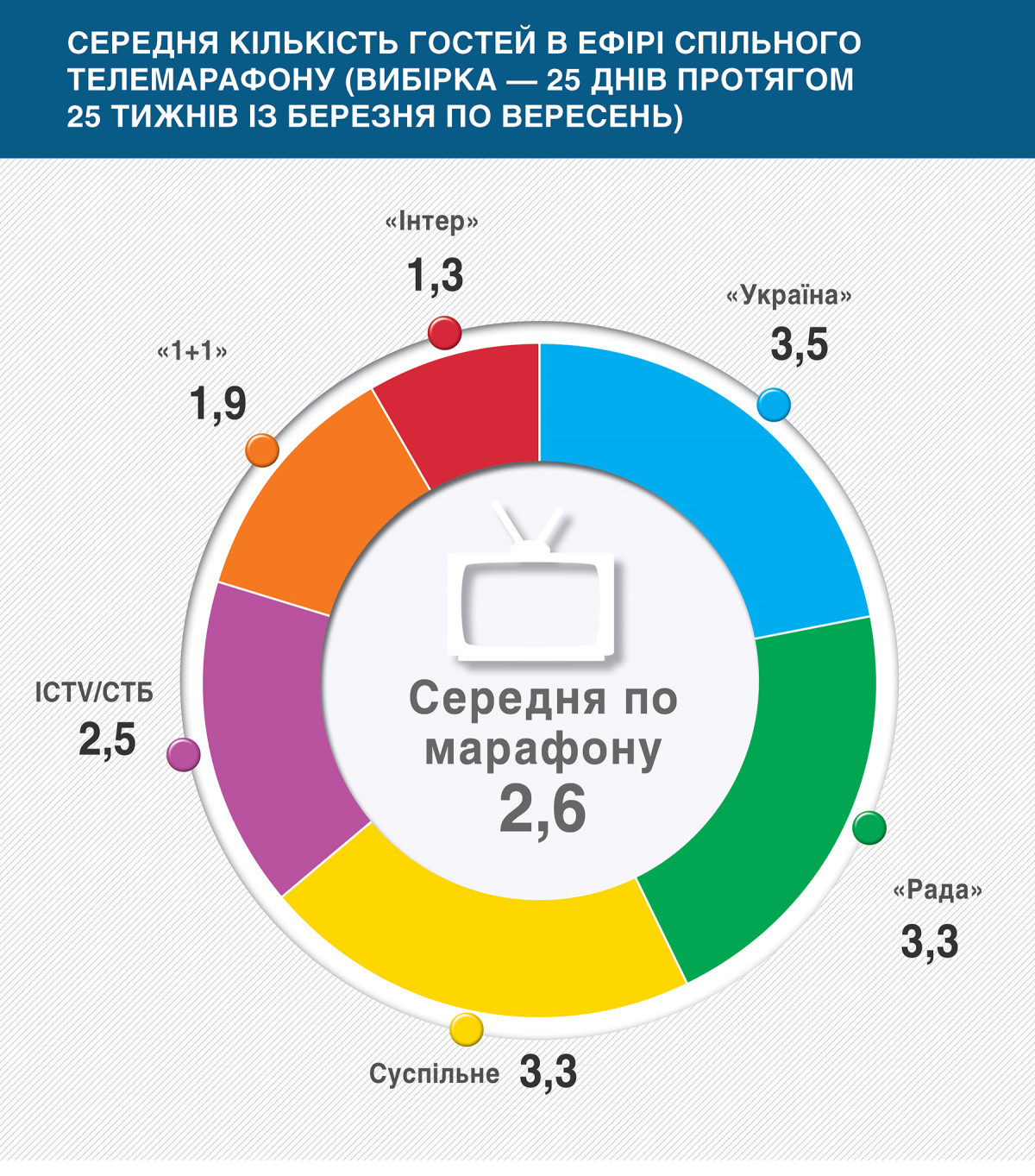
As we can see, the biggest number of guests is observed in the broadcast slots by Media Group Ukraine (which is not on telethon any more). The editorial rooms of “Rada” TV channel and Suspilne are not too far behind it. A little less number of guests at ICTV and STB channels is explained by the fact that media group’s broadcast is made half of the news releases (I have already mentioned it above) and, apart from the news, the share of the conversations in the studio is reduced by some other elements — large analytical video reports from the weekly programme “The Facts of the Week”, shown on the weekend, and numerous propaganda documentaries of the “Anti Zombie” and “Civil Defence” projects. At “1+1” channel the average number of guests is also significantly lower in comparison with the previous channels due to the larger news component in broadcast slots and more talking within the studio, where the TV hosts are communicating with each other. Besides, at this channel they often talk for a long time to the guest in the studio (I cannot say this is bad, the most important thing is that the guest is interesting). The least number of guests in observed in “Inter” broadcast slots, where the time for the guests in the studio is filled, apart from the guests, by numerous videos. At the beginning of telethon there were mostly the video reports only. There were broadcast slots without any guests, for instance a 5-hour slot on April, 25th, or there was less than one guest per hour, as it was on July, 18th and August, 20th (two guests per six broadcast hours).
On the other hand, the quantity does not always mean the quality. For instance, in Media Group Ukraine and “Rada” channel slots, the studios with the guests sometimes reminded the production lines, where the hosts hurried the guests and often said good bye without letting them finish the sentence, though the guest was telling something interesting. All this was accompanied by the words “We do not have enough time”. This is not the best way to fill your broadcast time.
In general, 1,502 guests visited telethon studios during the broadcasts, analysed by the monitoring. I have divided them into the following categories:
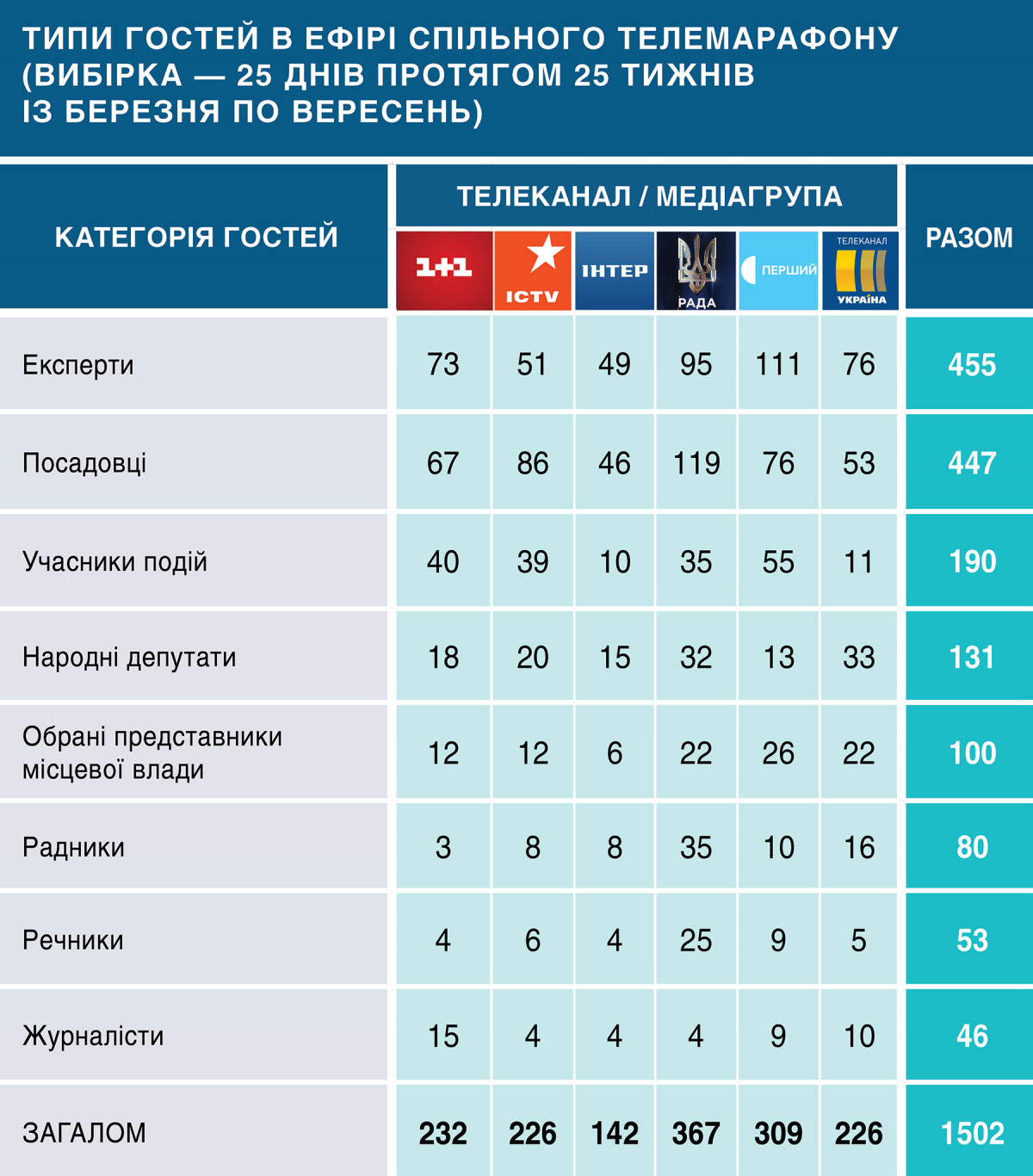
The division in percentage looks as follows:
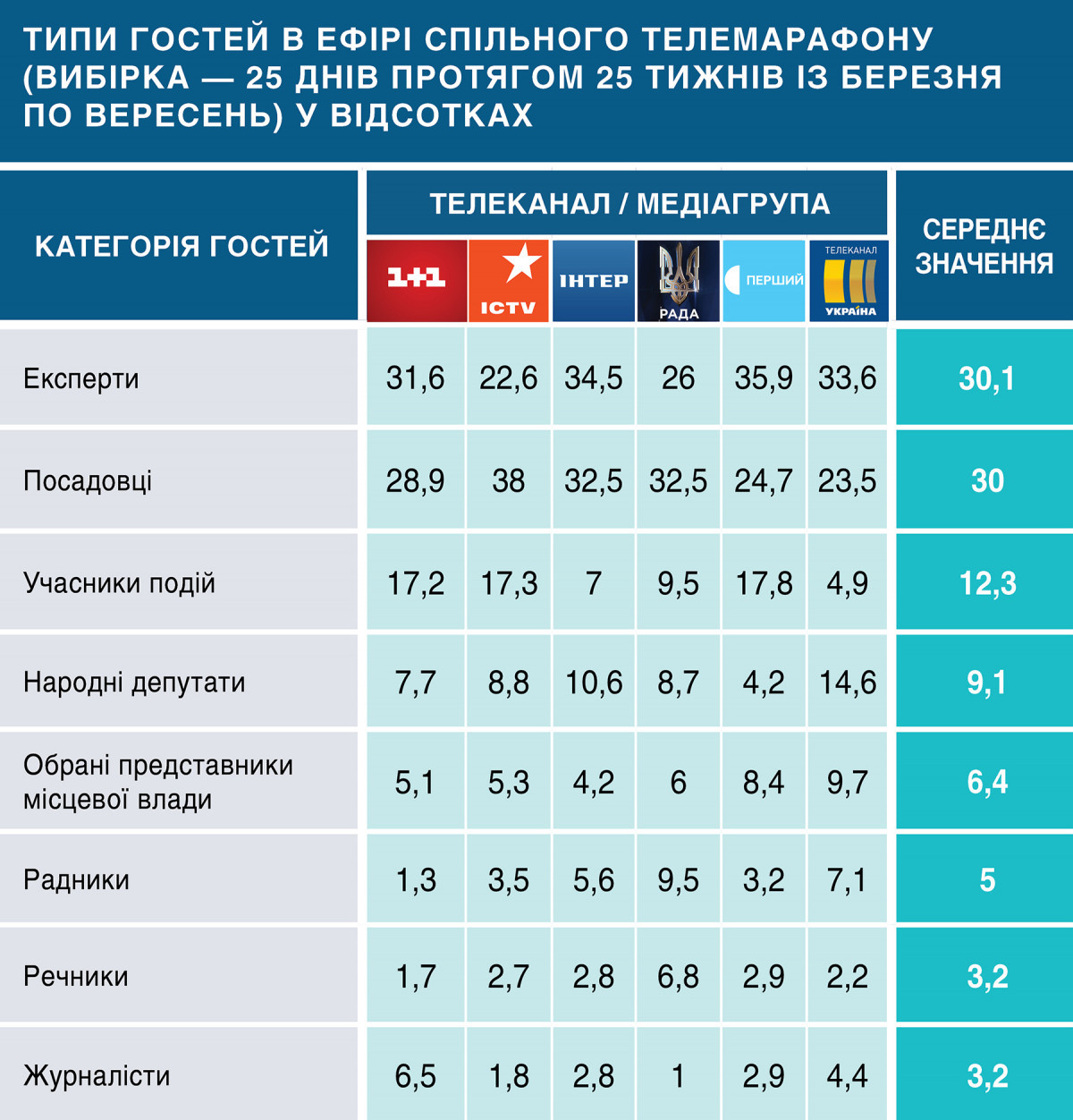
So, in general the telethon broadcast is dominated by officials of different ranks and experts in different fields (this is almost two thirds of all the broadcast time for the guests in the studios). The third place is taken by the people’s deputies, then there are the participants of different events (among them — a lot of service people, volunteers, refugees and internally displaced people, people, who survived the occupation, etc.) and the representatives of local authorities (city mayors, united local communities’ heads, local councils’ deputies). Certainly, the officials, MPs and local authorities are often the sources of actual information, and MPs-politicians and the experts are the sources of different subjective opinions in relation to the current events (assessment, conclusions and interpretations). The spokespersons (mostly for military offices, where the information is extremely portioned) have also added some part of the actual information.
The percentage of different advisors among the guests was unexpectedly high. As for me, this is a serious warning. On one hand, not always the actual information, being publicized by the advisors, is true. Because, on the contrary to those, to whom they “advise”, they do not have any personal responsibility for the work of their bosses (here we can remind of Oleksiy Arestovych as an example). On the other hand, the advisors often act in the telethon broadcast as experts. But, again, a classic expert is supposed to be unbiased while the advisor is working for a particular administrative body, so, he cannot be fully unprejudiced in the assessment of this body’s operating. The journalists, invited as telethon guests, were acting either as events participants or eye witnesses or sometimes as experts. The latter is not actually a function, attributed to a news reporter.
If to look at the broadcast structure for the guests in the studios, applying the telethon participants’ criteria, some essential differences among them are observable.
At “1+1” channel the number of politics and officials was a little less that the average indicator. Instead, the number of the events participants and the reporters as guests was significantly higher. The number of experts was also a little higher than the average. ICTV and STB channels media groups mostly counted on officials and events participants. Instead, there were fewer politicians and the representatives of the local administrative authorities and just a few experts (in contrast to other channels). At “Inter” the number of MPs and official was distinctively higher than the average. There was a considerable number of experts too. Instead, the number of events participants was much less than at other channels. Surprisingly, at “Rada” channel, the number of MPs was less that the average indicator (though “Rada” is a parliamentary channel). There were also less events participants and experts. Instead, there was a record number of advisors (we do remember about the precaution). In Suspilne broadcast slots there was the lowest number of the people’s deputies and a few officials (the less was only in Ukraine broadcast slots). Instead, there was a relatively high number of experts and events participants among all the channels. In Media Group Ukraine broadcast time, on the contrary, there were relatively more MPs and the representatives of the elected local authorities. There were also a few official and even less events participants.
Under present circumstances, when the political struggle within the country has been allegedly “paused” (at least, in words), the guests’ political affiliation seems to be of no importance. But, in reality, the involvement of the different political forces representatives to the telethon broadcast is obviously disproportional even to their representation in the parliament (that is the approximate division of those political forces’ supporters in the society). To illustrate this, let us have a look at the people’s deputies who are present (or not present) in the telethon broadcasts. As one can see from the previous tables, the presence of MPs in the telethon broadcast in a little more than 9 percent of all the guests (which is actually a significant part of the telethon). The distribution of the broadcast time among different political camps representatives, according to my observations for 25 days, having been analysed for a half a year, goes as follows:
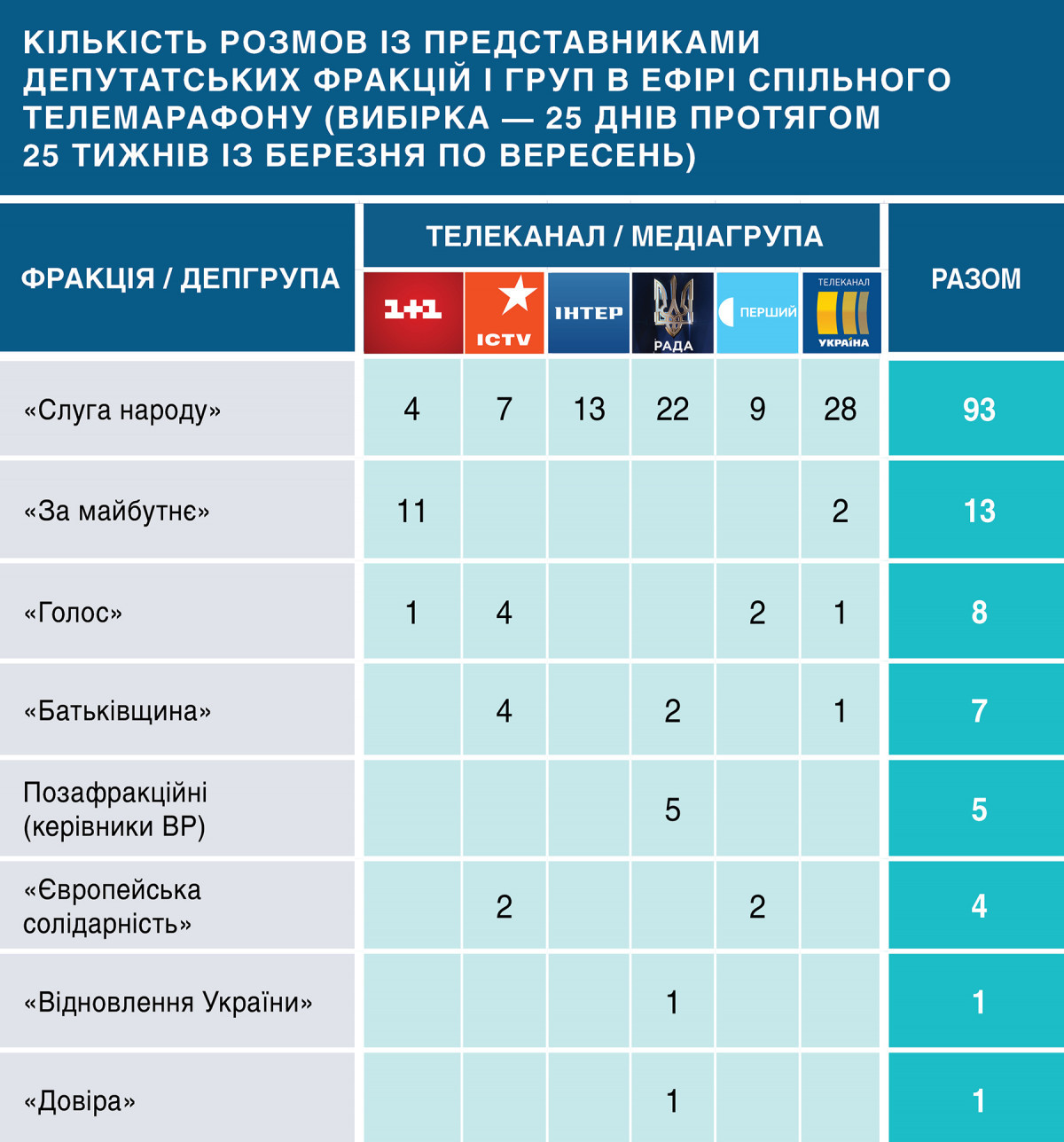
This is how it looks like in percentage:
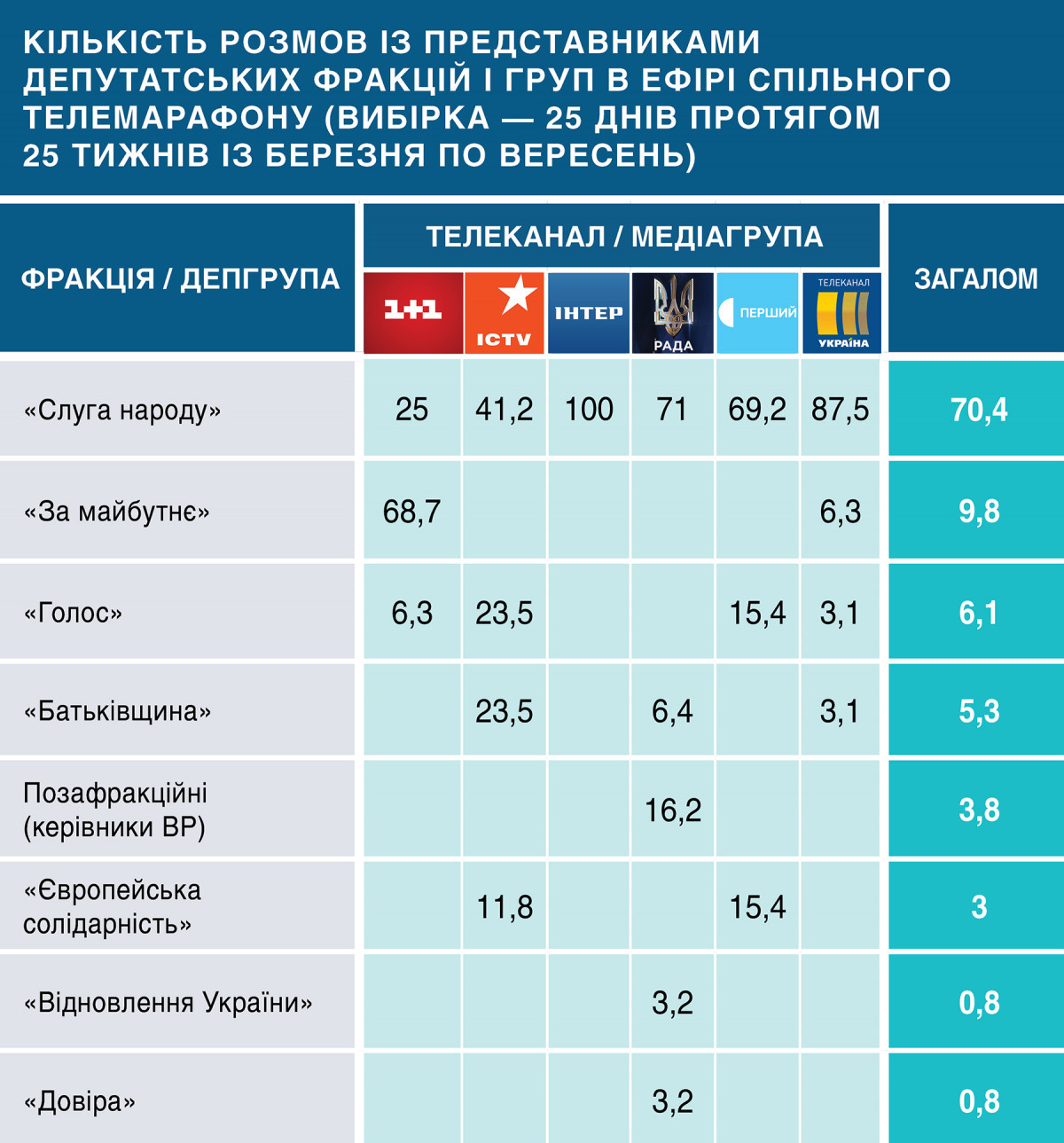
What do we observe here? First of all, the absolute domination of the “Servants to the People” over other political forces, this is totally predictable. This preference varies greatly for different channels / groups: from a hundred percent of “Servants” at “Inter” channel (which always, even in its OPZZh (“Opposition Platform – For Life”) times, was trying to share the news broadcast time with the ruling political party) till 25 percent at “1+1” (which is totally predictable as the channel owner Mr Kolomoyskyi prefers his own political party “Za Maibutnie” (“For the Future”). “Rada”, Suspilne and Ukraine were keeping the 70-percent “trend”. As for me, the interesting fact is the weak representation of the “Servants” in the broadcast slots of Viktor Pinchuk’s media group (the joint broadcast of ICTV and STB channels). I do not have any assumptions concerning that. The high average percentage of the “Servants” in the broadcast is, certainly, explained by their “elevated” representation in the parliamentary specialized committees, as in majority of cases the appearance of this or that “servant” was legitimized mostly by his competence in this or that issue as the corresponding committee member. But then a counter question can be asked: if the representatives of other political forces are also within the committees, why the “servants” are being chosen in most of the cases? We will come back to this question a little later.
Some other illustrative tendencies can be observed from the info graphics above. First of all, in “1+1” broadcast, the biggest share of MPs-guests (two thirds!) was indecently, in my opinion, represented by “Za Maibutnie” parliamentary group, inspired and sponsored by the channel owner. (Looking ahead, I can say that this channel, in most of the cases, also deliberately mentioned the political affiliation of these MPs in the hosts’ speeches or captions). Thanks to this, the parliamentary group gained an unjustified opportunity to promote itself and had taken the second position as for the representation in the telethon, following the ruling party!
The presentation of “Holos” (Voice) parliamentary group in the telethon was also surprisingly high. Moreover, it was true for four channels’ / groups’ slots. “Holos” was totally ignored only by “Inter” and “Rada” channels. By the way, «Rada» publicly justifies the appearance of MPs-traitors from the former “Opposition Platform – For Life” in its broadcast slots by the fact that they “as the parliamentary channel are supposed to give the floor to the representatives of the parliamentary groups”. So, here comes the question: and where is the floor for “Holos” and “European Solidarity”? There is no floor for them in the parliamentary channel broadcast slots. As we can see, they have zero percent and zero chances. At the same time, in the analysed broadcasts, the floor was given to such marginal parliamentary groups as “Dovira” (Trust) or “Vidnovlennia Ukrainy” (Renewal of Ukraine) (where the remains of OPZZh (“Opposition Platform – For Life”) gathered together). The only thing left to be done by “Rada” is to democratically give the floor to the PZZhM (Platform for Life and Peace) (another OPZZh leftover).
Over these 25 days “Holos” and “European Solidarity” have been given the floor only by two telethon participants — ICTV with STB and Suspilne. “Holos” representatives were also invited to “1+1” and “Ukraine” (once per each), but it was dedicated to rather specific events (such as, for instance, the broadcast on August, 20th, when “Holos” MP Rustem Umerov spoke as the Head of the parliamentary Special Commission on the monitoring use of the Western weapons in relation to the Interpol thoughtless statement).
Two things more are to be mentioned. Over these 25 days, four times in ICTV and STB slot and twice in “Rada” broadcast, Yulia Tymoshenko was invited as a guest and the TV presenters talked to her in an extremely flattering manner (at “Rada” even the former presenter from the channels, owned by Medvedchuk, Maksym Zborovskyi expressed his excitement by saying “you talk about the right things”) and they did not prevent Ms Tymoshenko from exercising in her own promotion. And Media Group Ukraine broadcast in its style of operating from the previous peaceful years, as Rinat Akhmetov did not “put all his eggs in one basket”. The lion's share (that is, almost all) of the guest broadcasts was given to the ruling party. But MPs from “Za Maibutnie” (a curtsy to Kolomoyskyi) were invited twice, as well as one time visit for the representatives of “Holos” (a curtsy to “young opposition forces”) and “Batkivshchyna” (All-Ukrainian Union "Fatherland") (a curtsy to Tymoshenko).
In terms of MPs personal representation, the full picture for a half a year (let me remind you, 25 days - one day per week), goes as follows:

Let us analyse the upper part of the list. The sole leader for a half a year of the monitoring is Mr Fedir Venislavskyi (12 live feeds in the telethon). Certainly, Mr Venislavskyi is the Head of the Parliament Committee on National Security, Defence and Intelligence, vital under the war conditions. So he was competent to comment on the issues of national security, defence and intelligence that appear almost every day. But still... First of all, 18 people’s deputies are working within this Committee of the Verkhovna Rada. It would have been much better, if some of them (e.g., Davyd Arakhamia or Maryana Bezuhla) did not comment on these topics at all. Thanks goodness, I have not seen them at least on the telethon. But, within the Committee there are many more competent and, most importantly, reasonable people, for instance, Roman Kostenko (I saw him in telethon, unlike Venislavskyi, only twice and then he was talking about local combats at the south of Ukraine, in which he personally participated), or Serhii Rakhmanin, whom, to my great regret, I did not see in telethon even for a single time.
The convincing second position in the list is taken by Danylo Hetmantsev, who commented on issues within his competence as the Head of the Verkhovna Rada Committee on Finance, Taxation and Customs Policy for 9 times. And all would be well if Mr Hetmantsev was not, in my opinion, deservedly criticised for his “left-wing” approaches to taxation and customs policy. His opponents (concerning the economic issues, the approaches only!) such as Mr Hetmantsev’s First Deputy in the Committee Yaroslav Zhelezniak from “Holos”, were given the floor only three times (twice in StarLightMedia group slot and once in Suspilne slot).
The third position in this list (7 speeches in the telethon) goes to the present leader of the ruling party Olena Shuliak. On the air of different channels, she was giving comments on the draft law on the compensations to people for the property, destroyed by occupants and the country restoration in general. The topic is extremely favourable and, in most cases of her appearance, the hosts have introduced her as the “Servants to the People” party leader. Is it a coincidence? I do not think so. The only exception was Shuliak’s big interview to Suspilne, where they also spoke about the party matters, the relationship between the ruling party and the opposition and where the TV host was asking many uncomfortable questions.
Another “Servant”, Yevheniia Kravchuk, the Deputy Head of the Committee on humanitarian and information policy, was invited to those telethon broadcasts, which I saw, for 6 times (three times at Ukraine). In most cases, she commented on the external issues as the Representative of the Ukrainian parliamentary delegation in PACE. Here comes the question — why not to discuss these topics with some other Ukrainian delegation members, for instance, with Oleksii Honcharenko (but he is from “European Solidarity”) or Serhii Soboliev (he is from “Batkivshchyna”) or, at least, with Lesia Vasylenko (from “Holos”). Also, Ms Kravchuk was actively commenting on new draft law on media in telethon. And in this Ms Kravchuk was simply supporting “the party position”, which was skilfully introduced to the telethon broadcasts by the other “servant” — the Head of the Committee on humanitarian and information policy Mykyta Poturaiev. But there was a strong group of opponents to this draft law, which was not simply heard by the viewers.
I also have a lot of questions in relation to the commentaries on financial, taxation and customs policy issues by the “Servants to the People” representative Olha Vasylevska-Smahliuk. Formally she is a member of this special committee, but, I beg your pardon, her competence in these issues often looks like as neophyte’s ones (at least, judging from the professional background in this field and, frankly speaking, from my personal impression, caused by her replies to the questions, related to finances and taxation).
Summing it all up, I can say that all this provokes a lot of questions to the editorial policy within the telethon. The fact, that the total preference by most of the editorial rooms is given to the ruling party representatives, is obvious. Even in those cases, when these representatives’ commentaries quality on specific issue was lower than of their political opponents, the opponents were not given the floor at all or their chance to speak was very limited. This is one way or another: either the editorial rooms do not understand who of two similar speakers (based on their position) is better suited for revealing the topic or they have some established limitations for the inviting of certain political camps to the telethon broadcast. And what is even worse — the opponents of the ruling party do not have a chance to speak even in questions, calling for discussion (such as in case of the draft law “On Media” or in relation to the taxation pressure enhancement for the entrepreneurs).
The general list of the guests, visiting the broadcast during those days, monitored by me, is extremely large, so I will mention only those people, who visited the telethon for more than 5 times in these 25 days:

Here, as we can see, the sole leader appears to be Serhii Haidai, the Head of Luhansk Regional Military Administration (24 live feeds in all the channels without exception). I consider this understandable. The same thing is about live feeds of other local authorities representatives for the currently occupied territories or the areas, close to front lines: the Head of Donetsk Regional Military Administration Pavlo Kyrylenko (17 times as a guest in the studio), the Head of Kharkiv Regional Military Administration Oleh Syniehubov (11 times), Sumy Regional Military Administration Dmytro Zhyvytskyi (7), Zaporizhzhia Regional Military Administration Oleksandr Starukh (7), the city mayors of Melitopol Ivan Fedorov (14), Kharkiv Ihor Terekhov (14) and Mariupol Vadym Boichenko (7). Under the conditions of the limited access to these areas, mainly these people have the information, related to combat actions (though, it is also limited), the situation in the occupied cities (even if it is not full), humanitarian conditions, evacuation, etc. Apart from that, such important topics as the preparation to new school year at free territories as well as getting ready for the heating season have been also discussed during the telethon.
Despite various risks, which I have described above, the telethon journalist consider different advisor to be reliable sources of information, and sometimes even experts. For instance, the advisor to the Minister of Internal Affairs Vadym Denysenko had 17 live feeds to the telethon and other advisor of the same Minister, Rostyslav Smyrnov — 13, which ensured them the place in the top ten of this list. The advisor to the city mayor of Mariupol Petro Andriushchenko had 7 live feeds and the advisor to the Head of Dnipro Regional Military Administration Nataliia Babachenko — 5.
Serhii Bratchuk, the representative of Odesa City Military Administration still remains the most popular among spokespersons —16 live feeds in the telethon. The head of the united press centre of the Defence Forces “South” Nataliia Humeniuk (9 live feeds) and the spokesperson of the Air Forces Headquarters Yurii Ihnat are not too far behind him. I believe this is the result of the professional work and personal charisma.
I have already mentioned the MPs, given in this list. Among the civil servants, in my opinion, the relatively high position of Oleh Nemchynov (12 live feeds), the Minister of the Cabinet of Ministers, looks a little strange. At the same time, this minister without portfolio comments on too vast range of topics. Deputy Minister Hanna Maliar (9 live feeds) became the main communicator with the society on behalf of the Ministry of Defence long ago, as well as Deputy Minister Yevhen Yenin — on behalf of the Ministry of Internal Affairs, though the Minister Denys Monastyrskyi has also been the telethon guest for 5 times.
7 live feeds of Refat Chubarov, the chairman of the Mejlis of the Crimean Tatar People, have mostly been dedicated to the explosions at occupants’ military objects in Crimea, where Chubarov has his own information sources.
Among the officials, the telethon has been mostly visited by Deputy Head of the Office of the President Ihor Zhovkva (8 times), who commented the external affairs and aid to Ukraine. The issue of European integration has been most often discussed with the Vice-Prime-Minister Olha Stefanishyna (8 times). The Minister on the Occupied Territories Reintegration Iryna Vereshchuk during 8 live feeds to the telethon has commented mostly on the issues of evacuation and internally displaced persons. The Minister on Veterans’ Affairs Yuliia Laputina was invited to the telethon for 7 times. The Secretary of the National Security and Defence Council of Ukraine Oleksii Danilov was the telethon guest for 6 times.
The Minister of Culture and Informational Policy Oleksandr Tkachenkо has been invited to the telethon on several occasions 8 times. The Deputy Head of the National Bank Council Vasyl Furman in 7 live feeds commented on the issues, connected to the exchange rate policy and inflation. The Head of “Ukrposhta” Ihor Smilianskyi mostly talked about the symbolic post stamps, dedicated to the war (5 live feeds). The Head of “Ukrzaliznytsia” Managing Board Oleksandr Kamyshyn during 5 live feeds commented on the establishment of grain land export ways during the naval blockade of Ukraine and evacuation flights.
Among the military experts, the most “popular” at almost all the channels was Oleksandr Musiienko (10 times at 5 channels), the Director of the Center for Military and Legal Research. Apart from him, the hostilities were often commented by Dmytro Snehyrov (6 times), Oleh Zhdanov (6 times as well), the co-ordinator of the group «Information Resistance» Kostiantyn Mashovets and the former spokesperson of the General Staff Vladyslav Seleznov (5 times each). The international issues were mostly commented by Bohdan Ferens (7 times) and the former US Ambassador in Ukraine John Herbst (5 times). A historian Oleksandr Alforov in his 7 live feeds to the telethon mostly spoke about the changing of the streets names (he is the Head of Kyiv City Council Commission on this issue). Different questions were discussed by political commentator (usually captioned as “political scientists”) Ihor Petrenko (6), Serhii Kuzan (6) and Volodymyr Fesenko (5).
And just a couple of words to be added on the topics for the guests in studios, at least in the most general categories. This division was as follows:
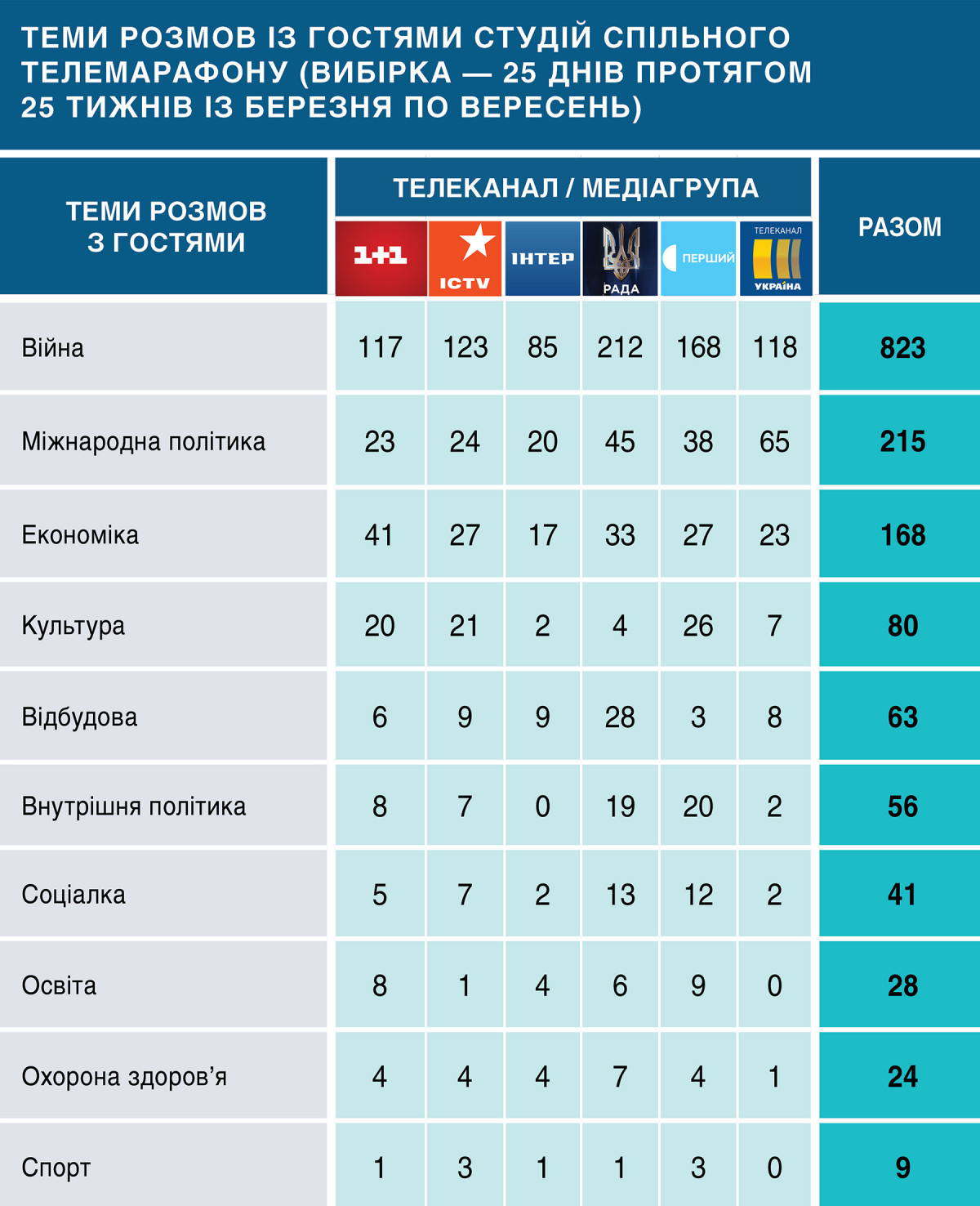
In percentage:
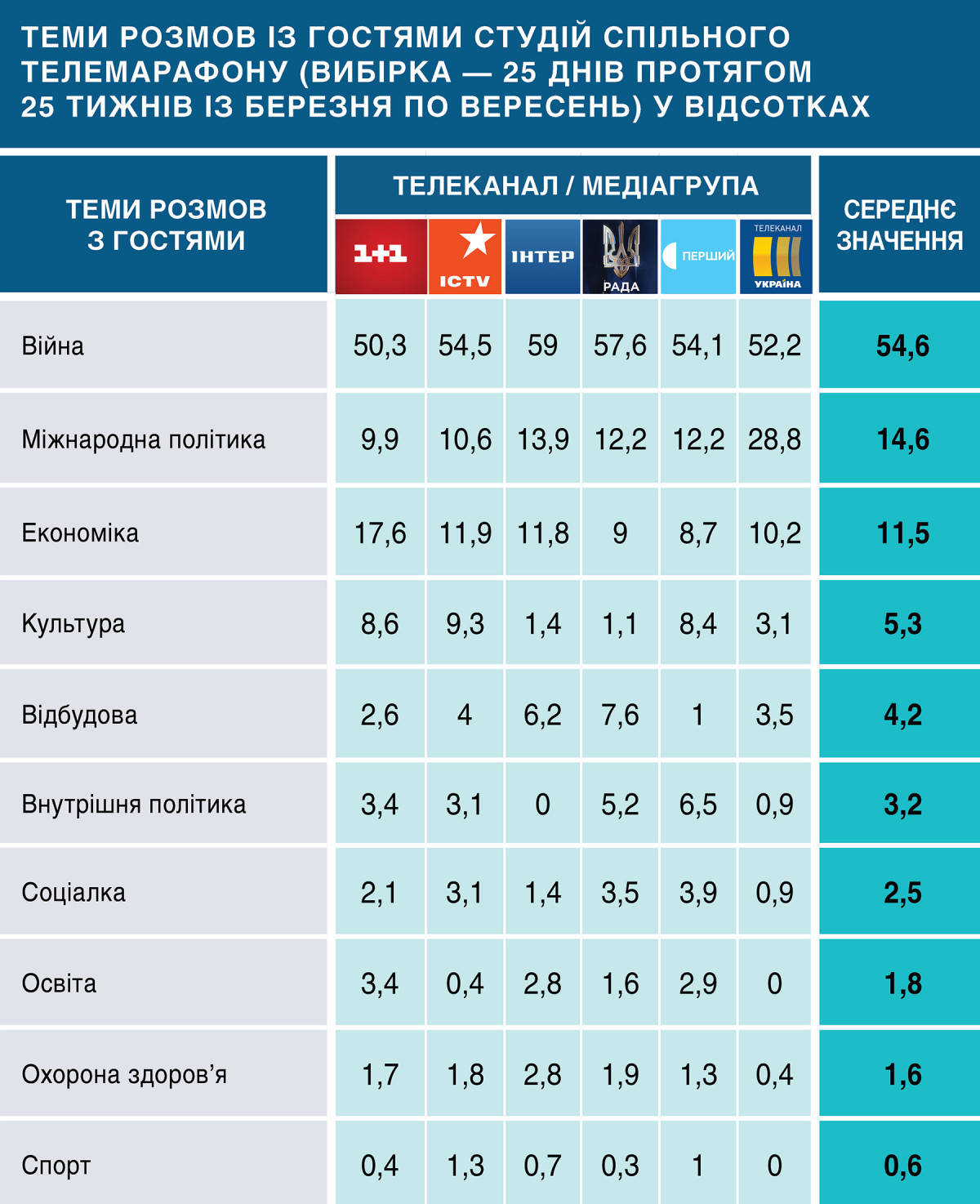
The fact that the events, directly connected to the war, dominated the conversations with the guests in the studio is totally predictable — 54.6% on average and no less than 50% all the channels without any exception. Actually, the telethon itself is often presented to the viewers by the hosts from different channels as “the channels have united to inform you about the events at war”. Though, as the time goes by, there can be traced a tendency that war is being moved to the background by some other topics. Yet it is my personal impression from the telethon weekly views, but I hope to show this tendency in a more illustrative way with the help of statistics in the second part of these 6-months conclusions.
The following things can be observed from the last table. “Inter” and “Rada” channels concentrated on the topic of war while talking to the guests the most. At “1+1” and in Media Group Ukraine slots they spoke to the guests about the war the least. Instead, the disproportionally large amount of attention in Ukraine slots was paid to international policy (almost one third of all conversations with the guests).
In general, the topics, connected to economics, have taken a lot of time in the conversations with the guests. 11.5% — the news did not contain so much of the “economics” even at peaceful times. And I have also singled out all the economic issues, related to the reconstruction of the property, destroyed by the enemy, into a separate category (“reconstruction”). The TV channels have obviously started to pay more attention to the economic since May. If you have a look at the table, you can see that, in comparison, “1+1” pays the most attention to the economic issues. My subjective impression from the watching goes as follows: sometimes it feels that there is no war in the country, as in “1+1” broadcast slot they are talking about the economics for hours.
Naturally, the internal political issues in times of war are considered to be of less significance. But they do not disappear completely, for example, the criminal proceedings against the oppositional politicians or the volunteers (this all is happening, despite the war and the society need to find out about it from the united telethon). At “Rada” and “Suspilne” channels they have talked to the guests about different issues of the internal policy substantially more that the others. At “Ukraine” the internal policy has been almost ignored and those topics have been totally neglected in conversations with the guests at “Inter”.
The social issues were mostly discussed at Suspilne and “Rada” and almost ignored in the studios with the guests at Media Group Ukraine. “Inter”, among other questions, mostly emphasized the health care issues, and once again, “Ukraine” did not mention this topics in discussions with the guests.
The cultural topics were mostly discussed at ICTV and STB channels, “1+1” channel and Suspilne. The least number of guests for cultural issues was at “Inter” and “Rada” channels. Despite the fact that the topic of education was the burning one in summer as the preparation to a new school year in war conditions was ongoing, in my opinion, it was not enough discussed with the guests in studios. It was mostly discussed in “1+1”, Suspilne and “Inter” slots, mostly ignored in ICTV and STB slots and totally neglected in Media Group Ukraine slots. The sport (where the Ukrainian athletes have had an enormous number of stunning victories) was somehow addressed at ICTV and STB as well as Suspilne.
To be continued.
Photo: “1+1 media”



